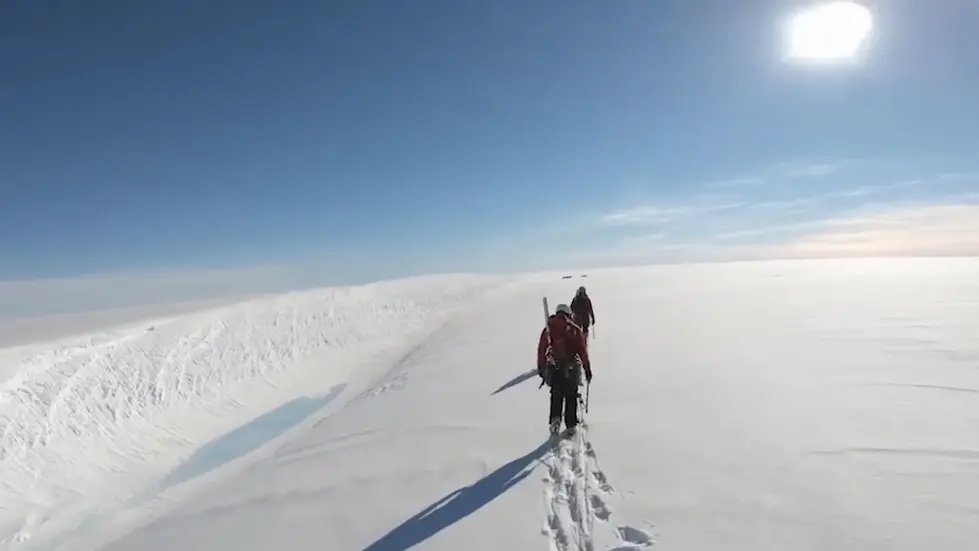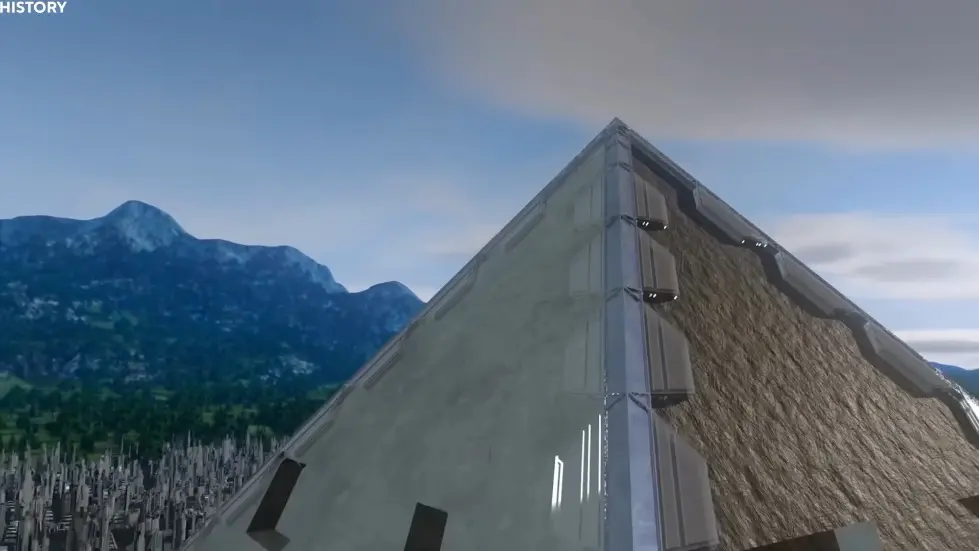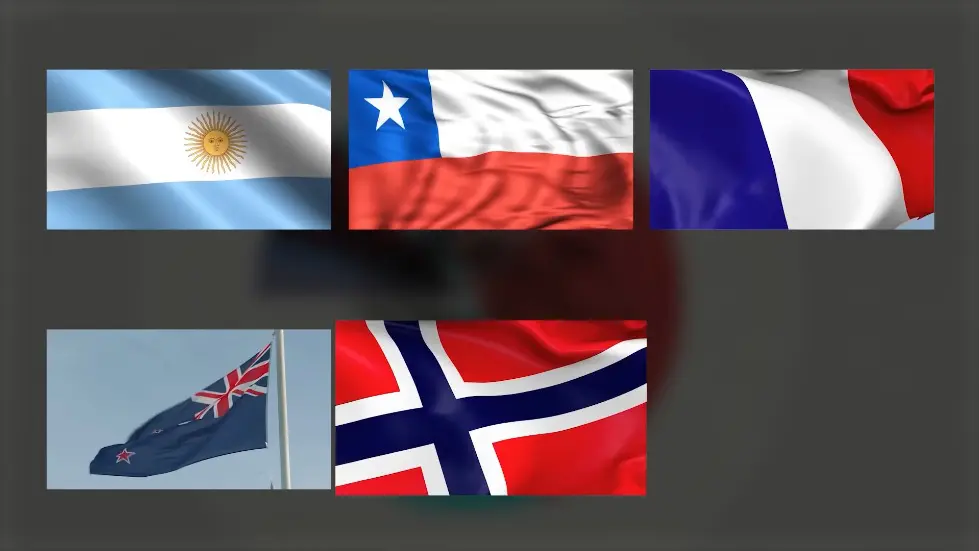Russia Reveals Antarctica Is Not What We're Being Told!
Last updated: May 17, 2023
The video discusses the discovery of a subterranean ecosystem beneath the Lassen ice shelf in Antarctica, as well as the surprising discovery that the Ross ice shelf is "singing" due to vibrations caused by wind and other environmental factors.
The video discusses the discoveries made in Antarctica, including the existence of a subterranean ecosystem located 1600 feet below the surface, which was recently discovered by researchers.
The ecosystem is home to tiny shrimp-like creatures and is located beneath the Lassen ice shelf.
The video also discusses the discovery of a singing glacier, the Ross Eye shelf, which was found to be continuously vibrating due to the active winds whipping over the uneven surface.
The researchers noticed that the features of the song were altered by events like storms or melting that affected the snow on the surface.
- Antarctica is a continent of extremes with vibrant and almost alien life formed under its thick sheet of ice.
- A subterranean ecosystem was recently discovered beneath the Lassen ice shelf, home to swarms of tiny shrimp-like creatures.
- The Ross ice shelf is "singing" due to vibrations caused by wind and other environmental factors, which can help scientists monitor the environment and its effects on the ice shelf.
- Microorganisms that eat wood and oil have been discovered in Antarctica, providing eco-friendly solutions for oil spills.
- Allen Hills 84001, a fragment of a Martian meteorite found in Antarctica, provides evidence that liquid water was present on the surface of Mars during the time of its origin.
- Blood Falls is a bleeding waterfall pouring from the Taylor Glacier in Antarctica's McMurdo dry Valley, offering a way to study subsurface microbial life in the region.
- The Weddell Polinia and Maud Rise Polinia are holes in the Antarctic ice that scientists are still unable to explain, but hope to use to learn more about climate change.
- Antarctica has left us all awestruck with its hidden secrets, and there may be many more discoveries yet to be made.
- Studying Antarctica's features isn't an easy job, but almost everything on our planet is connected in one way or another.
Russia Reveals Antarctica Is Not What We're Being Told! - YouTube

Introduction
- Antarctica is the fifth largest continent on Earth, covered with ice and a polar desert without a native population.
- Over the years, exploratory expeditions have discovered the unthinkable in this continent of extremes.
- Antarctica has preserved vibrant and almost alien life formed under its thick sheet of ice for millions of years.
- The melting ice and human contact have revealed astonishing features in this enigmatic part of our planet.
- Unique microorganisms alien to the rest of the world and stranger glaciers that sing have been discovered in Antarctica.

Subterranean Ecosystem
- Deep below the icy sheet of Antarctica is an extraordinary ecosystem that escaped the radar for too long.
- A subterranean habitat was recently discovered by researchers beneath the Lassen ice shelf.
- The subterranean habitat is home to swarms of tiny shrimp-like creatures.
- The researchers drilled about 500 feet below the surface of the ice and finally reached the chamber hiding under the ground.
- The lens of their camera was swarmed by incredibly small crustaceans called Hampton pots.
- The presence of these animals swimming around 1600 feet below the surface clearly indicates that a remarkable ecosystem process is underway.

The Singing Glacier
- The massive Antarctic ice shelf named Ross Eye shelf is alive with the sound of music.
- Researchers began analyzing the seismic data from 34 extremely sensitive sensors that placed under the snowy surface of this Glacier.
- The top layer of snow was continuously vibrating due to the active winds whipping over the uneven surface.
- The ice was humming at a frequency of 5 Hertz.
- Storms or melting that affected the snow on the surface altered the features of this song.
- The sound was compared to a constant blowing flute.

Russia Reveals Antarctica Is Not What We're Being Told! - YouTube
Conclusion
- Antarctica has left us all awestruck with its hidden secrets.
- The discovery of a subterranean ecosystem beneath the Lassen ice shelf and the singing glacier are just a few examples of the astonishing features of this enigmatic part of our planet.
- Experts have suspected the presence of a huge network of rivers, estuaries, and lakes under Antarctica, but studying the features of this continent isn't an easy job.
- Almost everything on our planet is connected in one way or another.

Ross Ice Shelf
- The Ross ice shelf is "singing" due to vibrations caused by wind and other environmental factors.
- Scientists think that monitoring this song of Ross Eye shelf can help them remotely track surface shifts ahead of time.
- Using this, scientists will be able to paint a better picture of the eye shelf stability.
- They can find out if the Shelf is vulnerable and when it might collapse.
- This song may not be audible to human ears but it is an exceptional tool we can use to monitor the environment and its effects on the ice shelf.
- It's amazing how the largest piece of ice in the world is speaking to us.

Microorganisms that eat wood and oil
- Robert Blanchette discovered three new species of fungus in Antarctica.
- These three species were feasting on historic treasures in Antarctica.
- The three huts were being attacked by native species.
- Researchers are astonished by how tough these fungal species are.
- One of the species native to Antarctica is apparently devouring the petroleum spilled from fuel containers.
- Multiple species of bacteria have also been identified that degrade petroleum products.

Allen Hills 84001
- Allen Hills 84001 is the name given to a fragment of a Martian meteorite found in a place called Allen Hills Antarctica.
- A team of American meteorite hunters from the hands met project discovered this meteorite on December 27, 1984.
- It weighs 1.93 kilograms and originally belongs to the sugartite nakhlite chassignite group that originally came from Mars.
- The chemical analysis of this rock provides evidence that during the time of its origin liquid water was present on the surface of Mars.
- In September 2005, an analysis of the origin of alh 84001 was shared using the data obtained from.
- Experts believe it's one of the oldest meteorites originating from Mars.

Conclusion
- Antarctica is a mysterious land with many discoveries yet to be made.
- Microorganisms that eat wood and oil could provide eco-friendly solutions for oil spills.
- Studying the Ross ice shelf's song can help scientists monitor the environment and its effects on the ice shelf.
- Allen Hills 84001 provides evidence that liquid water was present on the surface of Mars during the time of its origin.

Meteorite from Mars
- EOS chasma in the valley marineris is the source of a meteorite that hit Earth around 13,000 years ago.
- The meteorite, ALH 84001, is the only one that came from wet Mars.
- In 1996, scientists claimed to have found evidence of Martian bacteria in the meteorite, but the theory was rejected by most of the scientific community.
- The discovery set the precedent for breakthroughs in astrobiology.
- There may be other meteorites carrying fossilized Martian bacteria.

Blood Falls
- Blood Falls is a bleeding waterfall pouring from the Taylor Glacier in Antarctica's McMurdo dry Valley.
- The waterfall's red color was initially attributed to red algae, but it was later found to be caused by iron-rich hyper saline water from a brine lake under the rock.
- The lake is sealed off and covered by 400 meters of ice, making it a sort of time capsule for ancient microbial populations.
- The waterfall offers a way to study subsurface microbial life in the region without drilling deep into the polar ice cap.
- Many lakes like this one may exist under the frozen surface of Antarctica and are home to microorganisms we have no clue about.

Weddell Polinia
- The Weddell Polinia is a hole the size of Ireland that was first spotted in 1974 near the Antarctic ice.
- The hole opened again in 2016 after remaining closed for 40 years.
- Scientists are still unable to explain this odd phenomenon.
- The Weddell Polinia is around 31,000 square miles at its peak.
- Scientists hope to use it to learn more about climate change.

Maud Rise Polinia
- The Maud Rise Polinia is another hole discovered in September 2017 in the Lazarev Sea of Antarctica.
- It was caused by cyclones carrying aggressively strong winds over the ice pack, forcing the ice to shift in opposite directions.
- Before 2017, the only known polinia was the Weddell Polinia that was caught on satellite in the 1970s.
- More of these holes may appear due to global warming.
- The occurrence of these holes is as scary as it is intriguing.

Subterranean Ecosystem
- Discovery of subterranean ecosystem beneath Lassen ice shelf in Antarctica.
- Explorers have discovered multiple species of microbes, crustaceans, and strange alien-looking fish.
- Some fish have relatively bigger eyes because they have to live and navigate in darkness.
- Some fish were orange, some were black, but the most striking and largest among these were see-through.
- Scientists have attributed their evolutionary success to adaptation, having antifreeze glycoproteins in their bodies that prevent the fluids inside them from freezing.

The Ross Ice Shelf is "Singing"
- The Ross ice shelf is "singing" due to vibrations caused by wind and other environmental factors.
- It took years to drill through the Ross Eye shelf and reach these life forms.
- Only a decade ago, nothing was thought to be able to survive underneath these massive ice sheets of Antarctica.
- The pressure and movement created by the ice sheets paired with geothermal heat provide these fish with water that's perpetually minus 2 degrees Celsius.
- According to Reinhold Hennel, a biologist at the Johann Heinrich Von Thunan Institute of Germany, see-through fish constitute 91% of the total biomass and 77% of species down there.

Pyramids in Antarctica
- Pyramids have been spotted in Antarctica, jutting straight out of the ice and snow.
- One of these massive pyramids has a perfectly square base measuring two kilometers square in each direction.
- Many stories from Polynesia tell us about people who managed to reach the Antarctic continent.
- The British Antarctic expedition that discovered this pyramid was shocked by its perfect appearance and decided to call it the pyramid.
- Geologists have revealed that the pyramid in reality is the peak of the 400 kilometers long Ellsworth mountain range.
- Experts have rejected the conspiracy theories proposing that this pyramid is evidence of life existing in Antarctica before it was wiped out by ice.

Conclusion
- Antarctica is not just a useless chunk of ice and remained ignored by humanity.
- There is a subterranean ecosystem beneath the Lassen ice shelf in Antarctica.
- The Ross ice shelf is "singing" due to vibrations caused by wind and other environmental factors.
- Pyramids have been spotted in Antarctica, jutting straight out of the ice and snow.

Discovery of Human Remains in Antarctica
- Two centuries-old bones were found in Antarctica in 1985.
- A skull and femur bone were discovered close to remnants of a sealer's camp.
- The bones belong to an indigenous woman from Chile who died between 1819 and 1825.
- She was among the earliest explorers who landed in Antarctica.
- Female sealers were unheard of during the time she was alive.

Political Implications of Human Remains Discovery
- Many nations around the world are secretly preparing to claim Antarctica as their property.
- The Antarctic Treaty System prohibits all activities relating to the mineral resources of the continent.
- The protocol allows the treaty to come under review in 2048.
- Seven countries have laid claims on the Antarctic land.
- The skull of the Chilean woman may not bear much legal weight, but if Chile can prove their people started living in Antarctica long before the others, they might hold a stronger hand in negotiations.

Cryosineite Holes in Antarctica
- Cryosineite holes are water-filled cylindrical holes that often appear on the surface of glaciers.
- There are deposits of dark-colored sediments at the bottom of these holes.
- Particles from power plant emissions and volcanic eruptions make their way to Antarctica and deposit in these holes.
- These dark materials tend to absorb heat from sunlight, causing the ice beneath them to melt.
- The cryosine sinks into these holes, creating a black inner layer at the bottom.

Monstrous Worms Found in Antarctica
- Eulogiska gigantia is an eight-inch long worm with an oval body ringed with gold bristles.
- It belongs to a class of marine polycheet often called bristle worms.
- There's very little information available regarding the behavior and biological features of this strange worm.
- The sharp teeth of this entire scale worm indicate that it either preys on other smaller animals or scavenges on their remains.
- A photo circulating on Facebook shows a specimen with its jaw extruded.

Discovery of Subterranean Ecosystem and Singing Ice Shelf in Antarctica
- Scientists have discovered a subterranean ecosystem beneath the Lassen ice shelf in Antarctica.
- The ecosystem consists of bristle worms covered by scales called Electra, which serve as armor and camouflaging equipment.
- The worms play a vital role in the ocean's ecosystem and are preyed upon by shrimp.
- Bristle worms are resilient creatures that can survive in extreme environments, including hydrothermal vents and sub-zero temperatures.
- The Ross ice shelf in Antarctica is "singing" due to vibrations caused by wind and other environmental factors.
- The melting ice sheet in Antarctica is causing the continent's bewildering secrets to unravel, including the possibility of ancient human settlements and evidence of life forms alien to the modern world.
Watch the video on YouTube:
Russia Reveals Antarctica Is Not What We're Being Told! - YouTube
